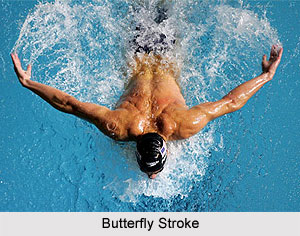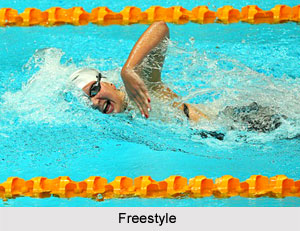 There are various types of strokes in swimming. Strokes are the main force which helps a swimmer to move ahead in water. Also assists in gaining momentum, and helps to keep afloat. The various types of strokes used in swimming are discussed below.
There are various types of strokes in swimming. Strokes are the main force which helps a swimmer to move ahead in water. Also assists in gaining momentum, and helps to keep afloat. The various types of strokes used in swimming are discussed below.
Freestyle: Freestyle means that the swimmer may use any style he wishes to. In modern days, the competitors use the "front crawl". In front crawl the arms are carried through the air, one at a time, elbow relaxed and the hand turning palm downwards ready to catch the water as the other arm is pulled under the water. The legs are kept constantly fluttering all the while; left leg with right arm and vice versa, to maintain balance. Breathing is done by turning the face and inhaling/exhaling. Breathing is generally done once in one arm cycle.
Back Stroke: Back stroke is front crawl done on the back. Since the nose is in air all the time there is no breathing problem. This makes the style very easy to perform. The arms are lifted from beside the legs, palm turned outwards, to an easy position behind the head. As the leading hand takes hold of the water to pull, the other one begins to lift from the side. This cycle is repeated while the legs are fluttered all along. Some swimmers raise and pull with both arms together.
Breast Stroke: This is the oldest and the slowest stroke and is defined by the FINA in the following manner:
1. The body shall be kept perfectly on the breast and both the shoulders shall be in line with the water surface.
2. All movements of arms and legs must be simultaneous in the same horizontal plane.
 3. The hands shall be pushed forward together from the breast and must be brought back on or under the water surface.
3. The hands shall be pushed forward together from the breast and must be brought back on or under the water surface.
4. In the leg kick, the feet must be turned outward in the backward movement (frog kick). A dolphin kick is not permitted.
5. At the turn/end of the race, both arms must touch the wall simultaneously.
6. During each complete arm cycle some part of the head shall break the surface of the water except during the starting dive and during each turn.
Butterfly: It was developed from the breast stroke and was declared the fourth stroke in 1952. The style, once again clearly defined by the FINA, is as follows
1. The arms must be brought forward over the water and brought backwards in water simultaneously.
2. The body must be kept perfectly on the breast and both the shoulders in line with the surface of the water from the beginning till the end.
3. All movements of the feet must be executed simultaneously. Dolphin kick is permitted. At the turn or at the finish the wall must be touched by both hands at the same level.
4. At the start and at turns, a swimmer is permitted one leg kick and one arm pull under the water which must bring him to the surface.
 Medley: This is an event where all four strokes are to be executed by swimmer. The order of strokes for individual medley is butterfly, back stroke, breast stroke, and freestyle. In team relays, the order is back stroke, breast stroke, butterfly and freestyle. In both types of medley event, the distance to be swum in each style - known as leg- is equally divided. For relay, it is 4 x 100 m while there are individual events over 200 and 400 m, i.e., for swimmer covering either 50 or 100 m in each style.
Medley: This is an event where all four strokes are to be executed by swimmer. The order of strokes for individual medley is butterfly, back stroke, breast stroke, and freestyle. In team relays, the order is back stroke, breast stroke, butterfly and freestyle. In both types of medley event, the distance to be swum in each style - known as leg- is equally divided. For relay, it is 4 x 100 m while there are individual events over 200 and 400 m, i.e., for swimmer covering either 50 or 100 m in each style.
Relays: These are quite similar to athletic relays and are obviously team events. They are generally freestyle. At the change over, the previous competitors must have touched the wall before the next one leaves the diving block. Only the first swimmer can set an individual record in a relay if officially informed earlier. In medley relay each of the four swimmers executes one stroke whereas in individual medley the same swimmer executes all four strokes.
Turning at the end of the Bath: The following are the rules for turning at the end of bath:
1. In freestyle (front crawl), the touch on the wall may be made with any part of the body.
2. In back stroke, the swimmer must stay on his back till his head or the foremost part of the hand touches the wall. He may now turn beyond vertical but must come back onto his back before his feet leave the wall.
3. In breast stroke, the touch should be made with both hands simultaneously.
4. In butterfly, the breast stroke rule applies.
5. In medley he/she has to comply with the rule of the stroke he/ she is doing at the particular moment. Long distance swimming takes place in open water for distance over 1,500 m.
Synchronised Swimming: This form of swimming, ballet in the water was recognised internationally in 1952, by the FINA and is now a part of the Olympics. There are three types of events-solo, duet and team.




